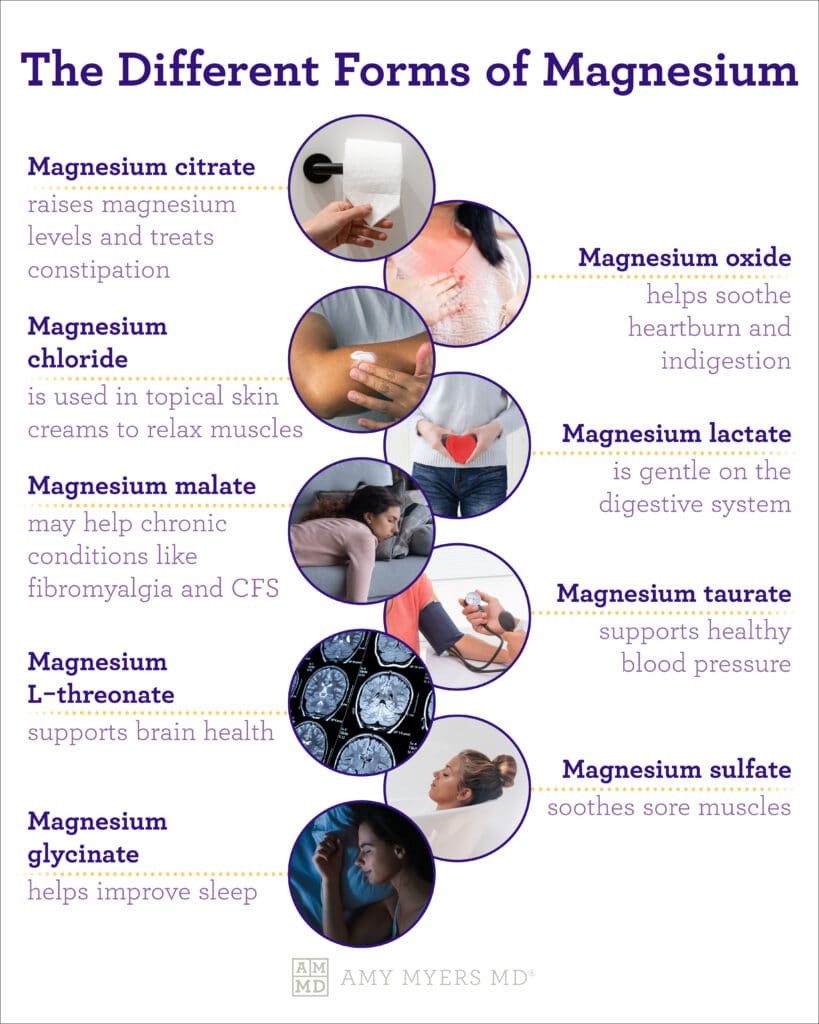Magnesium is one of the unsung heroes of optimal health. Signs of magnesium deficiency can vary from person to person. That said, it was one of the most common nutrient deficiencies I saw in my years as a practicing physician. What’s fascinating is that there are many forms of magnesium. Each plays a role in keeping you healthy.
Currently, there is no data on magnesium levels in Americans. However, food surveys by the National Institute of Health suggest that as many as 90% of Americans may have signs of magnesium deficiency. Adolescent females and men over 71 years old seem to be the most at risk1
Magnesium is involved in over 300 biochemical processes in the body. It supports healthy bowel patterns and promotes optimal sleep. It also relaxes tight muscles and facilitates heart health. However, magnesium supplements at the store often go by different names. This might lead you to wonder, what is the best form of magnesium?
There are eight common forms of magnesium. In this article, I will tell you all about each. In addition, I will share how each supports your body and how to ensure you get the best form of magnesium. First, let’s have a quick refresher on magnesium and why you need it.
What is Magnesium?
If you took chemistry in high school, you likely worked with magnesium (Mg). In nutrition, magnesium is a mineral needed in larger quantities. This is unlike trace minerals, such as zinc or iron. The Recommended Dietary Allowance (RDA) for adults between the ages of 19 to 51+ is 400 to 420 mg daily for men. Women need between 310-320 mg per day. Pregnancy requires about 350-360 mg daily and lactation 310-320 mg.Remember, the RDV is the amount The Food and Drug Administration recommends to prevent illness, not for optimal health. For example, the RDA for vitamin C is 65 to 90 milligrams per day. One cup of broccoli will provide you with the recommended amount of vitamin C, according to the RDV. However, your body needs up to 2,000 mg of vitamin C to function optimally.2
For magnesium, the optimal amount depends on the form of magnesium. In general, 350 mg from supplements provides optimal amounts. Any extra magnesium from food gets eliminated by the kidneys through your urine.3
As I mentioned, magnesium plays a role in over 300 metabolic reactions. It is also essential to support healthy bones. This explains why about 50-60% of our body’s magnesium is in our bones. If an element is an essential mineral, that means you can only get it from food and supplements. Magnesium-rich foods include spinach, avocado, figs, bananas, Jerusalem artichokes, and wild-caught salmon.
It’s almost impossible to get optimal amounts of magnesium from food. That’s why supplementing with high-quality magnesium supplements is essential for optimal health. Yet, with all the types of magnesium, it can be frustrating to know which is the best form of magnesium. I’ve been there. I will now tell you about the nine most common forms of magnesium.
Eight Common Forms of Magnesium
People worldwide are getting less and less dietary magnesium every year. We have a plethora of environmental practices to point the finger at for this. Additionally, dietary and lifestyle decisions negatively affect magnesium intake. Unfortunately, exercise, stress, and toxic foods can deplete magnesium reserves.

It can be tricky to decide the best form of magnesium for your needs. Let’s look at the nine forms of magnesium and what roles they play in your health.
Magnesium Citrate
When I had my colonoscopy, I had to take high doses of magnesium citrate the day before. This form of magnesium promotes healthy bowel patterns. It’s great for those who suffer from constipation. Magnesium citrate is also one of the most bioavailable forms of magnesium. This is why I included it in my Colon Comfort formula. It combines magnesium citrate with botanicals such as apple cider vinegar, ginger, and artichoke. This combination supports digestive health. It also promotes a healthy metabolism. Additionally, this form of magnesium also encourages healthy bone density and strength. That’s why I made sure it was part of OsteoDura™, my most comprehensive bone support supplement.
Magnesium citrate is a form of magnesium that’s mixed with citric acid. Citric acid is in citrus fruits such as oranges, grapefruit, or lemon. If you are sensitive to citrus, talk with your functional medicine provider. There may be better options for you than magnesium citrate.4
Magnesium Glycinate
This is another common form of magnesium. Magnesium Glycinate combines magnesium and the amino acid glycine. It’s also known as magnesium bisglycinate. Glycine is one of the amino acids used to build collagen protein. Getting enough glycine can help promote deep and restorative sleep5 If you’re looking for something to help you wind down in the evening, I recommend NeuroCalm Mag. It contains three forms of magnesium to promote relaxation, cognitive health, and mood. They’re also in highly bioavailable forms. This means you get the most absorption out of your supplements.
Rest and Restore is another relaxing supplement I recommend. It combines two forms of magnesium with L-theanine and Pharma GABA®. These work together to encourage optimal physical and mental rest.
Magnesium Oxide
Magnesium oxide boasts a wide range of health benefits. However, your body does not absorb this form of magnesium very well. Because of that, it’s not a good choice if you are trying to increase magnesium levels. Magnesium oxide supports digestion and relieves migraine headaches.6 It also supports healthy bone function, which is why it’s another ingredient in OsteoDura™. You can find magnesium oxide in its powdered form or in capsules.
Magnesium Chloride
Magnesium chloride is very similar to magnesium oxide, and you might find this form of magnesium in bath salts and skin creams. Unlike magnesium oxide, your body easily absorbs magnesium chloride. Even so, there’s no evidence that this form will improve magnesium levels. Magnesium chloride also promotes healthy bowel patterns and digestion.7
Magnesium Lactate
Magnesium lactate forms when magnesium binds to lactic acid. Your muscles and red blood cells produce lactic acid. It is often used as a food additive to increase acidity in beverages such as soda and juice. You don’t often find it used as a nutritional supplement.
Magnesium lactate absorbs well in the body. Also, it may be gentler on your digestive system than other types. This is helpful for people who need to take large doses of magnesium. It may also help those who cannot tolerate other forms. It also promotes a healthy stress response8
Magnesium Malate
This form of magnesium contains malic acid. Malic acid is a naturally occurring compound in foods like fruit and wine. Your gut absorbs magnesium malate very well. This is what makes it an excellent option for restoring your magnesium levels. I’ve included this form of magnesium in NeuroCalm Mag. NeuroCalmMag may help reduce occasional head discomfort while promoting healthy memory and focus. Additionally, it helps your body relax after a long day. Magnesium malate also has less of a laxative effect than other forms of magnesium.9
Magnesium L-threonate
This form of magnesium is a salt created by combining magnesium with threonic acid. Threonic acid is a water-soluble acid from the breakdown of vitamin C.10 This is one of my preferred forms of magnesium. I like it because it absorbs well and has many benefits.
Magnesium L-threonate supports brain health and function. In addition, it promotes a healthy nervous system and facilitates optimal sleep. It also promotes heart health and supports a healthy stress response. Plus, it promotes focus, learning, and memory. NeuroCalm Mag includes all this in an easy-to-take powder! Simply mix a scoop in a glass of water, and let the relaxation begin.
Magnesium Sulfate
This is the form of magnesium you are likely most familiar with. You might know it as Epsom salt. Magnesium sulfate forms by combining magnesium, sulfur, and oxygen, and it has the texture of table salt and dissolves in water.
Magnesium sulfate has diverse benefits, such as promoting healthy bowel patterns. However, its most popular benefit is relieving sore, achy muscles and promoting a healthy stress response. Magnesium sulfate dissolves in bathwater for a relaxing hot bath. I make my bath salts from magnesium sulfate, pink sea salt, and Lavender essential oils.
Now that you know the different magnesium forms, you might ask yourself, “which is the best form of magnesium?” The answer is the one that supports the entire body. Let me tell you about my two favorites.
The Best Form of Magnesium
Whether it’s magnesium for stress, digestion, or sleep, the form of magnesium you choose should be of the highest quality. In addition, it should be highly absorbable and well-suited to you.
NeuroCalm Mag is an excellent choice if you’re looking for cognitive support. This supplement contains a triage of magnesium malate, magnesium L-threonate, and magnesium glycinate. These forms promote enhanced memory and focus. They may also alleviate occasional head tension. If you want to facilitate healthy bowel patterns, then Magnesium Citrate is the best form of magnesium for you. Colon Comfort is the holy grail of magnesium supplements. It contains one of the most bioavailable forms of magnesium for your body to effectively use. In the 300-plus biochemical processes, it’s especially great for soothing constipation and digestive issues.
Rest and Restore uses magnesium glycinate, L-theanine, and Pharma GABA® to relax the mind and ease muscle tension in the body.
If you’re looking for comprehensive bone health support, I recommend OsteoDura™. Not only does OsteoDura™ contain magnesium oxide and magnesium citrate, it also includes Vitamin D3. Magnesium and Vitamin D3 work together to enhance your body’s absorption and utilization of the calcium in OsteoDura™. When I formulated OsteoDura™, I also included vitamins K1 and K2 to support calcium’s delivery into the bone mineral matrix.
The Final Word
The benefits of magnesium are vast! After all, it supports more than 300 of your body’s processes. This includes promoting healthy bowel patterns, optimal sleep, supporting a healthy stress response, and so much more. The best form of magnesium is one that supports your body. Colon Comfort and OsteoDura™ contain the highest-quality magnesium for optimal digestive and bone support. In addition, NeuroCalm Mag and Rest and Restore use a blend of magnesium and other nutrients to ease tense muscles and support optimal cognition. It’s truly a multi-purpose mineral for whole-body health!









Leave a Comment